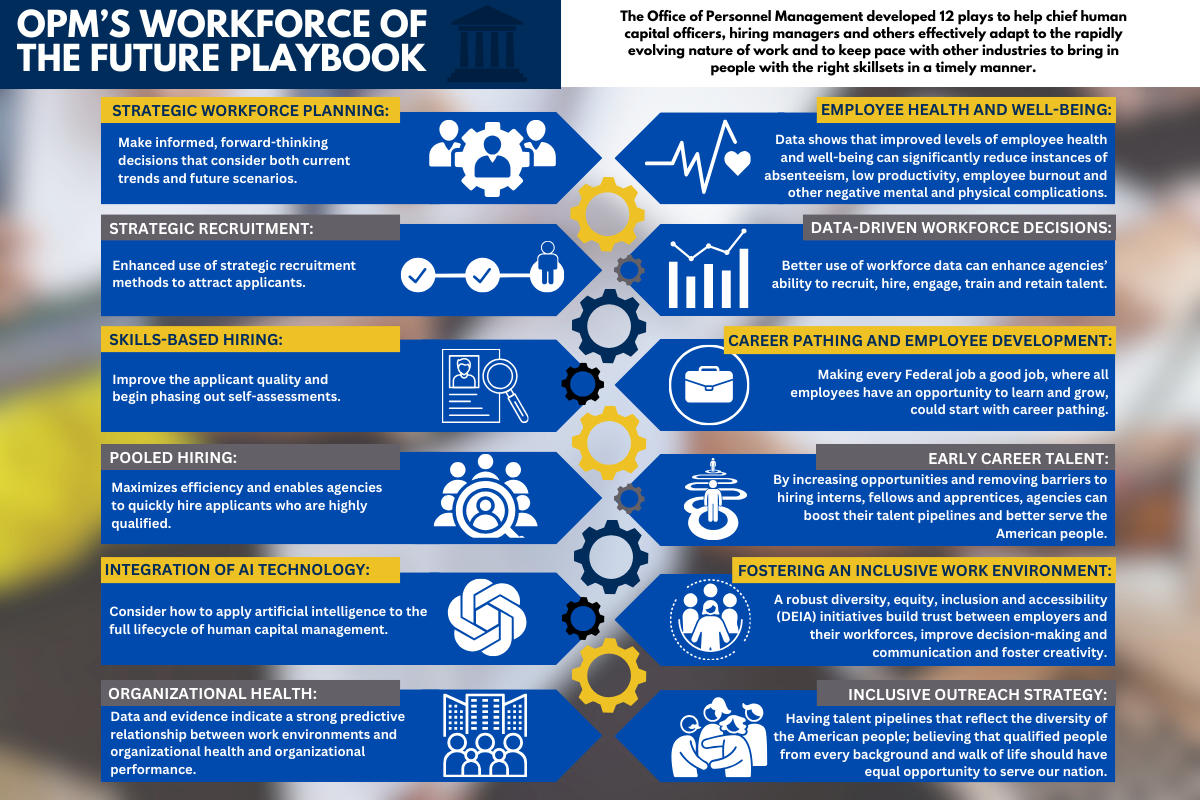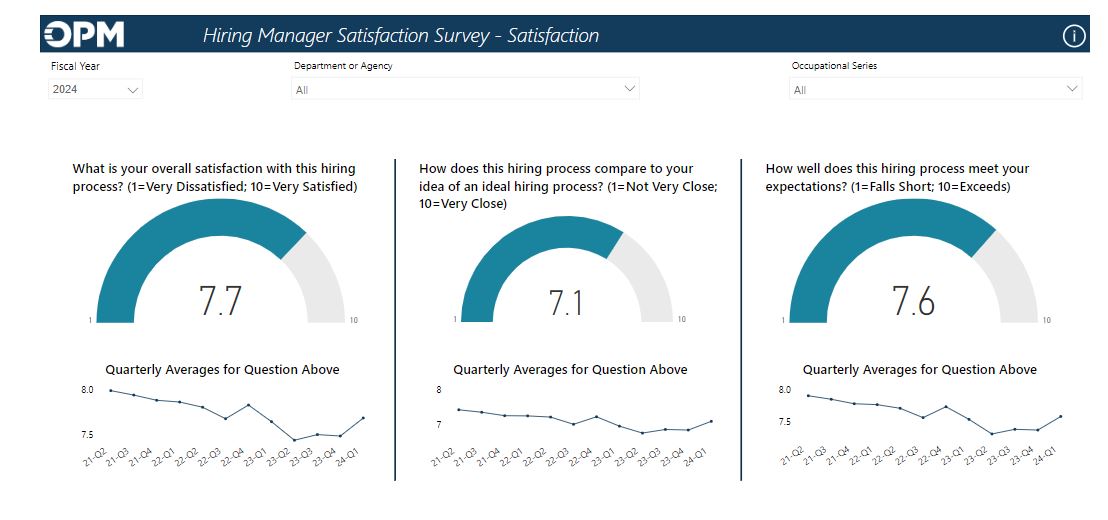OPM’s 12 plays to improve the federal workforce
Agencies can implement OPM’s new playbook to improve how they recruit, retain and manage their federal workforces today and in the future.
Few things in the federal community get as bad of a rap as the hiring process. It takes too long to hire federal workers. It’s too cumbersome. We have too many, or not enough authorities for hiring managers to understand.
Without a doubt the federal hiring process is an easy punching bag for agency leaders as to why their workforces are missing or can’t find the skillsets they need.
And while the federal hiring process, or for that matter any organization’s hiring process, is far from perfect, part of the problem for federal leaders, according to federal human resources experts, is they don’t understand, haven’t taken the time or just don’t care to know how to work within the system. The same can be said for firing employees. As one long-time chief human capital officer has often told me privately, the hiring and firing systems aren’t the problem, it’s the people and even the technology that fall short.
That systemic challenge of understanding the federal human resources system is exactly why the Office of Personnel Management is out with a new playbook that goes deeper, further and makes the processes easier to understand than most other playbooks, which have become Über popular over the last decade especially in the technology sector.
OPM is trying to supplant that purposeful, or accidental if you are being benevolent, ignorance that has built up over the last few decades by creating 12 plays around hiring, training and diversity and equity in its new Workforce of the Future Playbook.
“It’s really designed to help agencies implement many of the initiatives that we’ve already been talking about where we still know, there’s work that needs to be done, where agencies still are saying, ‘Hey, can you help us a little bit more with some of these areas.’ That’s what the playbooks really designed to do. It’s designed to be that implementation tool,” said Jason Barke, OPM’s deputy associate director for strategic workforce planning, in an interview with Federal News Network. “It’s got resources for agencies. It’s got examples from other agencies that have been successful. We talk about a ‘call to action,’ what you could do right now to start implementing some of these plays. Then there are some suggested metrics on what you could do to be able to measure to make sure that you’re being successful and we really think that if these plays are really implemented correctly, it’s really good to kind of give that roadmap on how we get to where we want to go.”

Each of the 12 plays aren’t just based on theories that haven’t been tried out in the real world or at such a high level that they are hard to implement.
OPM and its team that included agency CHCOs outlined for each play:
- The “why it matters,”
- The current and future state
- Promising practices, including agency examples
- Tools and resources
- A call to action
- Metrics to consider
Barke said OPM’s goal for the playbook was to make it easy to understand and useable for CHCOs, hiring managers and anyone involved with the federal workforce.
“As we began engaging with our stakeholders and talking about the plays, they said, ‘Oh, well, it would really be great if this got to a manager, and they said, Okay, what should I be doing now? You’ve given me a lot of information.’ That’s where the call to action came from,” he said. “We said here’s some steps you can take right away to be able to start implementing this, and then we wanted to make sure they knew if they were being successful or how they should judge how they’re doing. We started looking at some metrics. We really wanted to make it actionable, and really something that they really could use.”
OPM ramped up how it delivers metrics to agencies when it launched its new hiring manager satisfaction dashboard last April as well as one focused on the cyber workforce.
The hiring manager satisfaction dashboard shows a consistent set of scores over the last three years ranging from a high of 7.9 out of 10 to a low of 7.43 out of 10 for how satisfied respondents are with the overall hiring process.

That data and other survey efforts by OPM show there is not only room to improve, but the communication about the hiring process needs to get better.
Barke said OPM designed the playbook to keep the “HR speak” to a minimum.
“We did some usability testing with certain groups that were outside of that [HR] arena. We asked, ‘Does this make sense? Can you give us feedback?’ We were able to take that feedback and made sure that it was all relatable so that anybody that picked the playbook up [could use it],” he said. I use the example of a fish biologist or a meat inspector, who can look at that and say, ‘I need to do hiring or I want to make sure I have an inclusive work environment. How do I do that?’ We wanted to make sure the playbook is in very plain language. It’s something they can resonate with them that they can implement right away.”
One of OPM’s main goals with the playbook is to focus on new and existing authorities and practices “that have not been fully utilized but, if implemented, will serve as the foundation for a future that sees improved effectiveness and efficiencies in the federal government.”
Barke specifically highlighted the plays for using pooled hiring and skills-based hiring as two that agencies underuse across the government.
Recent successes of pooled hiring, where one agency, who’s already hired the candidates it needs off a list of qualified applicants, then shares that list with other agencies looking to onboard candidates for the same position, for positions in data science and a new service from USAJobs.gov to make hiring for similar positions easier.
Skills-based hiring has been in the federal sector since a June 2020 executive order by President Donald Trump and promoted by OPM in a new handbook issued in September.
OPM included play for AI
Barke said the playbook highlights how both of these approaches would speed up time to hire as well as ensure agencies are bringing on qualified candidates.
“We talk a lot about artificial intelligence in the playbook. AI is really on the forefront right now, this is something new, we haven’t been talking a lot about. And so there’s a play on AI and how we start thinking about that, and how that’s going to impact our workforce. So just a couple of plays that I would highlight right there,” he said.
Over the course of the next two months, OPM will hold several webinars to further socialize and educate the hiring managers and others on the plays.
One big key to success with a playbook is making sure employees not only know it exists, but what it means and how to use it.
Barke said OPM and the CHCO Council will pay close attention to the impact of the playbook based on a set of metrics, including the Federal Employee Viewpoint Survey (FEVS) scores.
“In certain areas that we’ll be able to monitor, we will look at those and be able to, just from an initial standpoint, know how many people were opening the playbook, how many are using it, some of the links that they’re clicking on. We’ll be able to understand if this is useful, and we’re going to evaluate the reactions after the webinars. And we do an annual CHCO survey,” he said. “I think it also is some of those things like we are seeing more requests for pooled hiring. Are agencies reaching out? Are we seeing more use of shared certificates? Are we seeing more skills-based hiring? There’s a website, hosted by GSA, that tracks skills-based hiring and how many are being hired. We’ve actually put in the playbook that you could click on that website and you could track to see how many alternate assessments are being used during these hirings.”
Barke added OPM will continually update the plays and add new ones to the document.
“If we see that there’s a gap or if we hear from CHCOs that there is another area that we really need help on, we’ll make sure that we start thinking about how do we have new plays that come out,” he said. “We work closely with the CHCOs and we’re going to have evaluations after these trainings, where we’ll get some feedback and say, ‘what else would you like to hear from us or what else may be missing in there? Are there other areas or other topics that are of interest to you or you need support on?’”
Nearly Useless Factoid
OPM was established in 1978, but its first iteration dates back to 1883, when the Civil Service Reform Act created the competitive civil service.
Source: OPM.gov
Copyright © 2025 Federal News Network. All rights reserved. This website is not intended for users located within the European Economic Area.
Jason Miller is executive editor of Federal News Network and directs news coverage on the people, policy and programs of the federal government.
Follow @jmillerWFED







